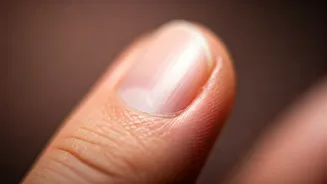Nails: A Health Window
Our nails, those seemingly simple keratin plates, often hold important health indicators. The half-moon shape, or lunula, at the base of the nail, is a key
area to observe. Its size, color, and presence or absence can provide insights into various health conditions. While changes in the lunula are not always indicative of serious problems, they warrant attention and potentially medical consultation. Recognizing the potential significance of these changes can lead to early diagnosis and proactive health management. Understanding your nail health can add an extra layer of awareness to your overall health and well-being. This awareness can improve health outcomes.
Lunula and Kidney Health
The appearance of the lunula can sometimes reflect kidney health. In cases of kidney disease, the lunula may undergo noticeable changes. One such change includes a diminished or absent lunula. The reduced size or complete absence of the half-moon might indicate a decline in kidney function, especially if coupled with other symptoms. Furthermore, discoloration of the lunula, such as a reddish or brownish hue, could signify issues linked to the kidneys. The connection between the lunula's appearance and kidney health isn't always straightforward, and these observations must be viewed alongside other health factors and medical evaluations. When observing changes in nail appearance, it's vital to consult a healthcare professional. They can provide an accurate diagnosis.
Lunula and Heart Health
The lunula can also provide subtle signs related to heart health. Changes in its appearance can, in some cases, signal underlying cardiovascular issues. The lunula may appear blueish or have a pale tinge. These color changes can indicate poor circulation or oxygenation, which might be associated with heart conditions. Another observation is an unusually large or prominent lunula. This enlargement may also require additional assessments. However, similar to kidney-related observations, changes in the lunula are never a definitive diagnostic tool. It requires a comprehensive approach. A healthcare expert can provide an assessment to ensure a suitable diagnosis. Any concerning changes should be investigated with a medical examination.
Interpreting Nail Changes
Variations in the lunula's size, shape, and color are essential. The absence of a lunula, or its reduction, may indicate poor health. Similarly, an exceptionally large lunula could also point toward underlying health problems. The color of the lunula is also a crucial factor. A blue or reddish tint may signify circulatory issues. White or pale lunulas might reflect anemia. Interpreting these changes requires an understanding of individual health history and potential lifestyle impacts. These observations should not be confused with self-diagnosis. Healthcare professionals need to assess these changes. They provide the right insights. This assessment is useful for a correct diagnosis. Consult a doctor if you are in any doubt.
When to Be Concerned
The appearance of your lunula, while not always a cause for alarm, does sometimes require attention. If you see significant changes in the size, shape, or color, or if these changes appear along with other health concerns, it's time to seek medical advice. If you have any concerns regarding the lunula's appearance, or if you also experience other symptoms like fatigue, swelling, or chest pain, you must visit a doctor promptly. Do not delay professional help. A health professional can provide a diagnosis based on a comprehensive assessment. They can help you address the underlying issues and promote overall health.










